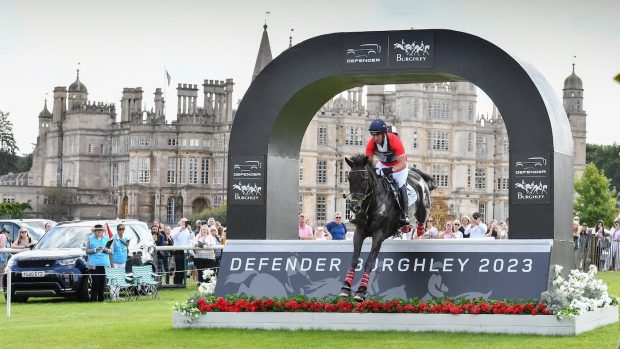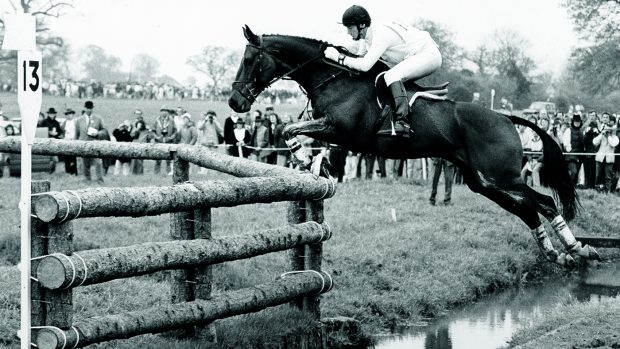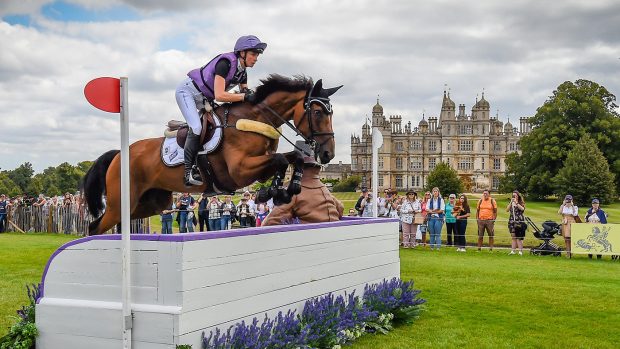Daniella Toomey has been head girl for Lucinda and Clayton Fredericks for 18 months: this week she is grooming for Clayton and Mr Moonstone at Burghley.
Colonel Mark Milligan’s Mr Moonstone, known as Ralph, is an 11-year-old 17.2hh grey gelding by Skylark. “Clayton has been riding Ralph on and off for five and a half years,” explains Daniella. “He has been competing in advanced classes all this year, including finishing 3rd in an advanced section at Aston-le-Walls 2. Burghley is his first CCI****.”
Grooming at three-day events
Daniella has groomed for the Fredericks at a number of three-day events, as well as riding her own horse at several CCI*s. She says the best part of grooming at three-day events is meeting up with all your friends and seeing the horses looking their best: “You feel so proud when the horses go to the trot-up and the dressage looking really smart. The worst part is Saturday night after the speed and endurance when you’re trying to get the horses sound and you’ve got too much to do.
“Grooming at Badminton last year was great because the horses have lovely permanent stables and grooms are provided with accommodation and all their meals free of charge.”
The experience can challenge everyone’s nerves. Daniella recalls one occasion: “My scariest moment with Ralph was watching him jump round Blenheim last year when he spooked at the writing on a big ditch and hedge. In general though he’s a really good cross-country horse so I feel quite confident watching him. He’s a horse with plenty of character who enjoys pulling me around when I’m grazing or walking him.”
So far at Burghley
The important role of the groom on Speed and Endurance day, especially in the 10 min box, is often publicised but what do grooms get up to the rest of the week? “Clayton has brought Darassas, known as Darley, with him to Burghley as well as Ralph. Darley is running at Blenheim next week so Clayton wants to work him himself this week, so I’m being kept fairly busy,” says Daniella.
“I arrived on Tuesday, ahead of the horses, so I put their beds down and got their stables ready for when they arrived. Darley and Ralph had been galloping on the way to Burghley so when they arrived they went into their stables for a bite of hay while we sorted out the lorry, put up the gazebo and so on.”
It’s important for horses to relax and have some grass when they’re away from home. Daniella continues: “Later I took the horses out in-hand for some grass before tidying their stables, doing their haynets and rugs and feeding them for the night. I always check the horses last thing in the evening before I go to bed as well.”
Wednesday is when the competition officially starts, with the important part of the day being the trot-up at 4pm. “This morning I fed the horses, did their hay, water and mucked out, groomed them both and gave them some grass. Then Clayton rode so I tacked up and washed the horses off, bathing Ralph ready for the trot-up when he got back. Then I plaited Ralph and that’s been my day so far. Now I’m just putting together his bridle ready for the trot-up and giving it a final polish.”
Looking ahead to Saturday
On Saturday the polishing of the trot-up and dressage will be replaced with all the action of the speed and endurance phase. “It’s a good idea to get all the stuff down to the 10 min box early in the day and stake out a good spot,” advises Daniella who shared her list for the box with H&H online:
- Headcollar with the horse’s number on it, leadrope
- Buckets, sponges, scrapers, towels
- Adjustable spanner, spare studs, nail for cleaning stud holes, spare shoes with studs in them
- Grease and glove for putting it on
- Spare whip, gloves, programme, seat, drink, coat
- Spare bridle, breastplate, martingale, reins with martingale stops, stirrup leather and iron, girth, overgirth, boots or bandages, overreach boots
- Spare bit if there is any chance the rider will want to change it
- Rugs for all weather conditions including waterproof rug
- Tape, scissors, hole punch, vaseline
In the 10min box
“Riders normally come into the D box a couple of minutes early so really it’s a 12 or 13min box,” explains Daniella. “One person should go to meet the horse, quietly put the headcollar on over his bridle, and once the vets have given you permission, lead the horse to where all your gear is ready, undoing the noseband on the way. The reins are pulled right up to the poll to prevent them getting wet, and one person holds the horse.”
For the next few minutes it’s all hands on deck. Daniella says: “One person then checks all the shoes and studs. Another loosens the girth and starts to wash off the horse, wiping down its head, neck and chest, under the front of the saddle and girth, across the hindquarters and between the back legs.
“How much water to use depends on how hot the horse is, but if it is very warm it may be necessary to put quite a lot on the neck and scrape or towel it off repeatedly, always taking care not to wet the reins. Try to squeeze out a sponge in the horse’s mouth as well.”
Daniella also warned that accidents can occur only too easily in the hurly-burly of the 10min box: “You have to be aware that the horse may be a bit of a different character because of the tense atmosphere to the laid back character you’re used to at home. Ralph is pretty good but it’s easy for people to get kicked when you’re all trying to be quick.
“Once the horse is washed off it can be walked, with a rug across the hindquarters if necessary. About four or five minutes before the off the girth and noseband should be tightened and grease applied down the front and back legs, though not on the chest as this inhibits sweating.”
Evidently the horses get plenty of VIP treatment in the 10 min box, but what about the rider?
“The rider should have been having a drink and a breather while the team deals with the horse; Clayton normally gets some advice from Lucinda about how the course is riding. Once the grease is on he can be legged up, and the reins and the bottom of his boots can be towelled off to prevent slipping.”
Once the rider’s on board it’s time to get ready for the horse coming back after its round. Daniella says: “The team needs to have a quick tidy up and refill the water buckets. Keep an eye on the horse and rider though, just in case the rider needs anything or the horse has to be led into the start box.
“Then, the team can relax — or try to — while watching the round. Blenheim is a great event in that respect as you can see almost every fence if you run, while the CCI****s have a closed circuit television tent. Make sure you get out ready to receive the horse when he comes through the finish though – whether it’s triumph or disaster there’s plenty of work ahead.”




